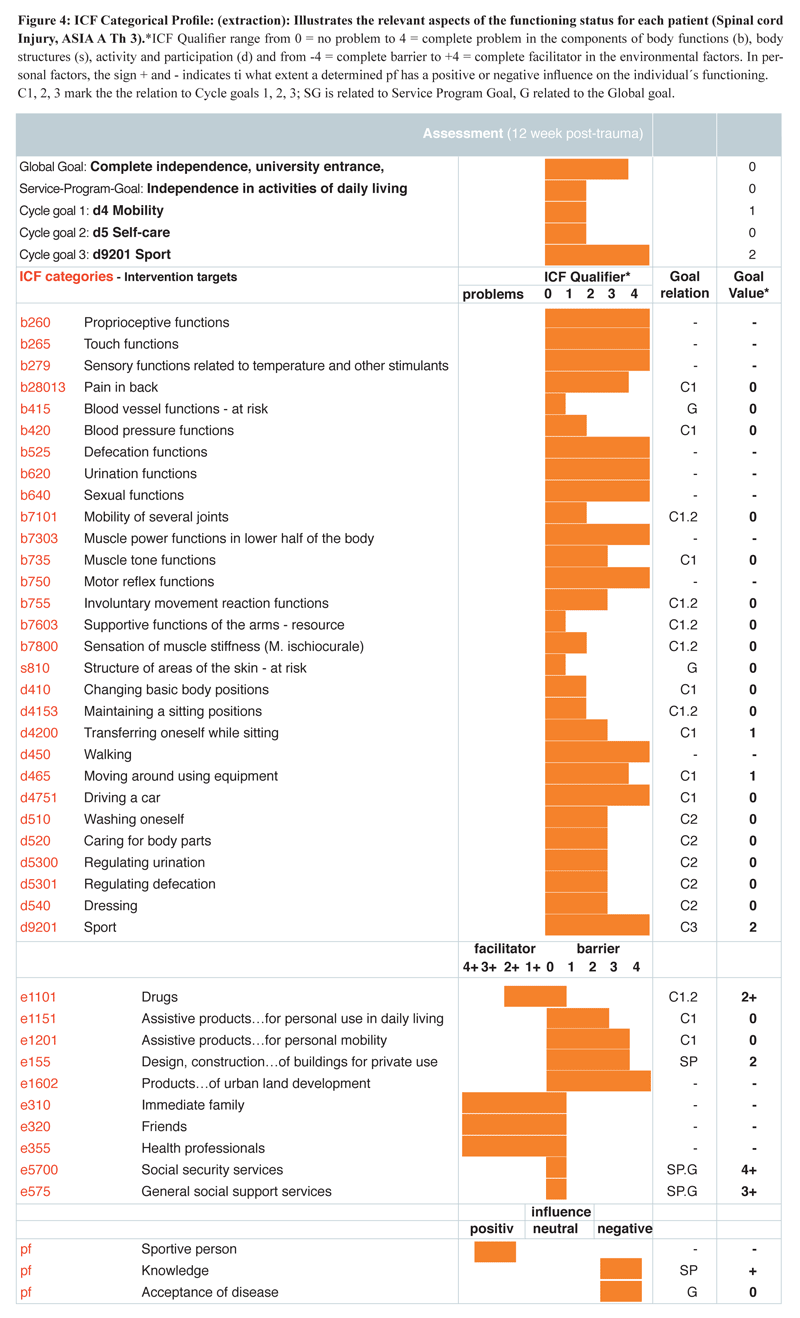The ICF Categorical Profile
The ICF Categorical Profile is a visual depiction of a person's functioning status at the time of assessment showing the qualifier values for selected ICF categories considered relevant to a individual patient's case. It can facilitate the identification of intervention targets that are related to shared goals, serving as the central source of information for the rehabilitation team for intervention planning.
Completing the ICF Categorical Profile requires the rehabilitation team, with input from the patient, to state long and short-term goals, link these goals with the ICF categories that should be targeted for intervention, and identify for each category the qualifier value that should be achieved after intervention. The ICF Categorical Profile is generally set-up using a suitable ICF Core Set. If no ICF Core Set exists for the respective health condition, the ICF Categorical Profile should include the ICF categories that are essential for comprehensively describing the health status of the person at the time of assessment.
ICF Categorical Profile
An ICF category is considered an intervention target if a goal is identified for it, and is intended to be addressed in the intervention phase of the Rehab-Cycle®. A category is marked as an intervention target using the following codes to illustrate its relation to the respective goals. These codes are seen in the column marked 'Goal relation':
- G = Global Goal; is the highest level goal a person aims to achieve, and refers to the intended outcome after successful completion of rehabilitation.
- SP = Service-Program Goal; is an intermediate goal a patient aims to achieve, and refers to an endpoint of a specific program of rehabilitation.
- ‘1’, ‘2’ and ‘3’ refer to cycle goals 1,2 and 3 respectively; a cycle goal is a short-term goal that a person aims to achieve. Several cycle goals are the “stepping stones” toward achieving the corresponding service-program goal.
In order to evaluate if a goal has been achieved, a goal value for each targeted ICF category has to be set using ICF qualifiers. Goal values are generally set only for those ICF categories which are considered intervention targets and have a goal relation.
The information found in the ICF Categorical Profile can serve as the basis for completing the next ICF-based documentation tool - the ICF Intervention Table.
Literature
- Finger ME, Selb M, De Bie R, Escorpizo R. Using the International Classification of Functioning, Disability and Health in physiotherapy in multidisciplinary vocational rehabilitation: A case study of low back pain. Physiother Res Int. 2014 Apr 15. Epub ahead of print.
- Glässel A, Rauch A, Selb M, Emmenegger K, Lückenkemper M, Escorpizo R. A case study on the application of the International Classification of Functioning, Disability and Health (ICF)-based tools for vocational rehabilitation in spinal cord injury. Work. 2012; 41(4): 465-474.
- Peter C, Rauch A, Cieza A, Geyh S. Stress, internal resources and functioning in a person with spinal cord disease. NeuroRehabilitation. 2012;30(2):119-130.
- Rauch A, Bickenbach J, Reinhardt J, Geyh S, Stucki G. The utility of the ICF to identify and evaluate problems and needs in participation in spinal cord injury. Top Spinal Cord Inj Rehabil. 2010; 15(4); 72-86.
- Rauch A, Cieza A, Stucki G. How to apply the International Classification of Functioning, Disability and Health (ICF) for rehabilitation management in clinical practice. Eur J Phys Rehabil Med 2008; 44:329-342.
- Rauch A, Escorpizo R, Riddle D, Eriks-Hoogland I, Stucki G, Cieza A. Using a case report of a patient with spinal cord injury to illustrate the application of the International Classification of Functioning, Disability and Health (ICF) during patient management. Phys Therapy. 2010; 90(7): 1039-1052.
